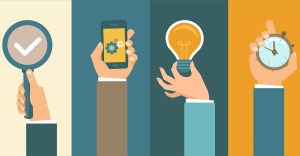In some circles, the term “customer journey” might be seen as an industry buzzword that doesn’t have any real effect on a department’s actual processes. Employees may believe that the path a customer takes from learning about a company and its products to making a purchase is something that can’t be shaped.
The concept of the customer journey is a marriage between knowing your target customer and adapting all interactions with them to encourage them to move forward in the purchase process. This idea is helpful for both B2B and B2C companies.
Though part of the funnel, the customer journey usually takes twists and turns that are harder to map. It’s not as simple as moving them down the funnel. Below, we outline why the customer journey is so important, as well as how to use it to your advantage in multiple departments as part of a cross-platform, cohesive strategy.
Customer Journeys Are Unavoidable
Even if you aren’t 100 per cent sure what every customer’s journey is—and no company can truly track each customer’s every move—the fact remains that they are all going on one. When a customer sees a product and buys it within a single interaction, they’ve still gone on a journey, albeit a short one. While this does happen, most customers’ journeys aren’t quite as simple.
They may be exposed to the brand and product multiple times through a variety of different platforms: billboards, ads, radio commercials, email campaigns, and word-of-mouth, to name a few. To see this in action from an online perspective, the Think With Google blog has a great tool that allows you to see the average customer journey across different business sizes and industries in specific countries.
A customer may fill their shopping cart on your e-commerce site, and then abandon it for a week before coming back to complete the transaction. Everything—from what brings them to your site in the first place, to what causes them to leave, to what brings them back, and what eventually drives their purchase decision—is part of the customer journey.
Map Out a Persona
To start mapping out customer journeys, create personas of your target customers and those who buy your products and services. It won’t help you to create “ideal” personas that aren’t actually buying from you.
Personas can help you see the buyer’s journey from your customer’s perspective. This can affect how you build your internal campaigns and processes. Shape personas by identifying a persona’s name, gender, age, occupation, lifestyle, and why they would purchase a product or service like yours. Outlining the problem they want to solve will help you.
Once you’ve created a persona, you can then identify possible interactions each persona could have with your company, including any hiccups or positive experiences they may have throughout the journey. This process is called customer journey mapping.
Customer’s Brand Sentiment Progresses The Journey
As you create your customer journey map, it is crucial to consider the customer’s emotions as they progress. Their experiences (and how they feel about them) automatically translate into brand sentiment. For instance, if a person is in the research stage, but finds your website difficult to navigate, that may make the overall path to purchasing longer (or, in the worst case scenario, may cause it to end).
On the other hand, when they find that your prices and product descriptions are better than competitors, and that you also offer free shipping, their brand sentiment is going to be positive. This goes right along with a positive customer journey that will be more likely to lead to a purchase.
EffectiveUI has a great example of mapping brand sentiment and emotions onto a customer journey map. Ideally, every step of the journey needs to include:
- The persona, as discussed above
- Emotional experiences, with associated milestones for each scenario (e.g. fills out a form to get a free ebook, but the link is broken; alternatively, calls customer service to ask a question and has an enjoyable interaction)
- Phases of the journey, from inquiry (researching and gathering initial information) to purchase and implementation into their lives or business
Customers Touch Multiple Parts of Every Brand
In the examples above, you’ll notice that customers are “touching” your brand in multiple instances. From exposure to and engagement with paid search ads during organic searching, to blog content they read from following a link on social media, the customer journey involves multiple departments.
In order to make a customer journey effective, it’s important to create a connected strategy that works with marketing, sales, and other departments. Strive to solve any potential journey roadblocks and foster the positive aspects of customer engagement that increase brand sentiment.
Share “What is a Customer Journey?” On Your Site











